Stories
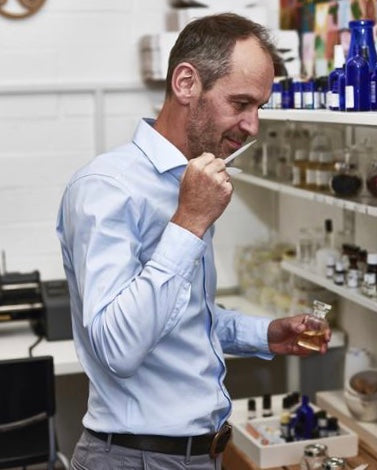
Benoit Nicol - The Nature of Things
Posted by Hannah Gumbrielle in: dublin, essential oils, handmade, ireland
Just a short walk from our shop on Drury St, Benoit Nicol runs The Nature of Things from the creative hub, the Chocolate Factory. Producing a range of beautiful essential oils and absolutes, we asked him a few questions about the process behind The Nature of Things.
Tell us a bit about what you make.
The Nature of Things launched 16 months ago with a collection of 15 pure essential oils. The collection has now grown to 27 botanicals and a beautifully designed diffuser. Our goal was to source the best essential oils we could find and bring them directly to consumers, encouraging everyone to (re)discover not only the beautiful scents but also the benefits of essential oils and how they can be used at home in very simple ways. Later, we will launch blends and perfumes and other natural and organic products, but we felt important to first introduce the oils in their purest form.

Could you describe your studio to us? What is your favourite thing about the
space?
My studio or workshop has three sections: the production area, the creative area and the admin/office area. The production area looks like a kitchen counter with the machines we use to bottle, cap, and label our products as well as store our bulk supplies. The creative area is a large white table with an electronic scale, a notebook, pipettes and blotters and boxes of empty or full glass bottles. Right in front on the wall are small shelves filled with my collection of natural oils and extracts (over 200 of them). This is where I sit to smell, compare qualities and create some blends or perfumes. The office area is full of books on oils and botanicals but also standard office supplies, computer, printers. In addition to the usual admin tasks, this is also where the shipments to retailers and customers are prepared. My favourite thing about the space is that it is located in a great building called The Chocolate Factory in the centre of Dublin. This is a community of like-minded artists and craft makers which also has the lovely Blá's Cafe on the ground floor. It has provided an ideal ground for me to run a small business, make new friends and connections. We also collaborate on creative projects; working with Kopper Kreation who have made copper props for me for my trade shows and fairs, Tricia Harris Design who has created beautiful wood boxes to showcase our oils, and Brendan Ryan Studio who has done the photo shoots for my products.
How do you get into the mindset of making?
When creating a blend or perfume, whether it’s for me or someone else, I like to work from an idea, a concept, some directions. If I was to create a blend for the Irish Design Shop for instance, we would discuss together the purpose of the scent (is it for someone to wear, to scent the shop), its olfactive direction (the type of scents), the ingredients that might be used or some other inspirations such as the atmosphere of the shop, the colour patterns, the texture of the products (wool or wood), etc. So creating for me would often be based on a collaboration, a discussion, a story.

What is your inspiration?
Inspirations are the essence of the creative process and they can come from the more unexpected places. They can have a direct connection to perfume making, such as something I smelled in the park, some food I had or other products I smelled in a shop. But they can also have more subtle or unconscious connections: an art piece, a discussion, a book, a trip somewhere, an experience, etc. The key is to be in tune with your environment, be social, be curious.
What is your favourite tool and why?
The essential tools to create a blend are a notebook, an electronic scale, an empty glass bottle, pipettes, samples of oils, alcohol and ‘mouillettes’ (ie blotter or smelling strip). And I would say the latter is my favourite tool. This is what you use at the end of the creative process to smell a blend or a pure oil so there is always a sort of excitement when you dip it in the bottle and bring it up to your nose to see what the result is. They are also important because they are usually let to dry a bit so we can go back and smell again 10 minutes or an hour later to evaluate how the smell evolves over time.

Can you describe your working process to us?
In my world the making or production itself is not all that ‘sexy’. It is very much about preparation and execution: making a last quality check on the oils we are bottling (smelling and comparing with previous samples), getting the raw material or blends ready, entering all the production and quality data on our spreadsheets, preparing the machines, supplies of labels and boxes, organising the work space and tools and making sure everything is clean and ready. It’s usually a small team of 2 or 3 people doing everything.
What led you to choose this craft as a profession? What do you love most
about it?
I like to think I had a predisposition for it with my interest in food and flavours growing up, as well as a very artistic and creative mind. I was lucky also to grow up in a beautiful countryside in Brittany and developed an appreciation and respect for Nature early on. But I fell into this world of perfumes and essential oils by chance really. And the more I learned the more I was hooked I guess. I really love the sourcing aspects of the oils; the communities behind them, the traditions, how they were discovered and used, and also of course the fascinating natural world and biodiversity that surrounds these plants and that we ought to nurture and protect.
The world of scents of course is a fascinating one, a sense we sometimes take for granted and neglect, but it is so central in our life.

How do your surroundings affect your work?
Creating requires a calm environment for a few hours so the first thing I need is to know that my most pressing jobs are taken care of, that my head won’t be distracted and I won’t be interrupted. I found that I am not able to get in the right space to create if the environment around me is chaotic. So I like to prep and have everything in order, with a clear desk. Ideally having a beautiful environment, space, and light is ideal. One of the companies I worked for in my past was located in the south of France and overlooked the beautiful hills of Grasse (the so called capital of perfumery) and I have to say that the sight alone gave a sense of joy and tranquillity.
What is your favourite oil to produce?
I think bergamot would probably be my favourite oil, with its mixture of sweet citrus, spicy, peppery and subtle floral notes. It also blends well with many other oils, such as aromatic herbal notes like rosemary or lavender, woods like vetiver or sandalwood, or flowers like jasmine and neroli. But bergamot also makes me feel happy and energised so this is the one I’d take with me on a desert island.
You can browse a selection of The Nature of Things in our store on Drury Street.

Sorrell Reilly
Posted by Hannah Gumbrielle in: design, dublin, handmade, Illustration
Clare based artist Sorrell Reilly creates bright, illustrative landscapes of the Irish countryside, starting off life as delicate lino prints and later digitized to add vivid colour. We asked Sorrell a few questions about her beautiful artwork and the process behind it.
Tell us a bit about what you make.
I make print artwork of the Irish landscape. I strive to make work that speaks to my soul, brings me joy and has personal meaning and connection with a certain place and time.
Could you describe your studio to us? What is your favourite thing about the space?
Myself and my husband have recently moved into a little cottage by the sea in Clare. We’ve made one of the rooms into a workroom and I love it!
I lived in Cork city for years and lived in some pokey flats, not big enough to swing a mouse! So coming out to the coast and having my own space with things around me that inspire me has been liberating. I’m so grateful for where we live. My favourite thing is hearing the seagulls and the waves while I work. In the summer I can take my work outside and I feel pretty darn jammy!

How do you get into the mindset of making?
I have to connect to my subject to get into the mindset of making. Often when I travel I use that time to self reflect and associate the place with a poem or song. And then later I revisit the words or music to get back to what I was experiencing. Music has a powerful way to travel you back to past feelings and to get into a creative head space.
What is your favourite tool and why?
Pfeil Lino cutting tools, my magic weapon. I know they say a poor workwoman blames her tools, but I think a good tool can shorten the distance between the artist and the art. And of course it can also make you feel like the business. I remember when I was a child I learned the piano but only had a keyboard to practice and then one day my parents bought me a beautiful upright piano. I adored it and couldn’t wait to wake up everyday to play. That’s what Pfeil cutting tools are like for me.

Can you describe your making process to us?
To start with I always draw a number of rough sketches to find a composition that I am happy with. After this, I try to find ways to add more design elements and motifs that I can use throughout the piece. This is often patterns and textures derived from plants, flowers, rocks etc. Once I am happy with the design I clean up the sketch and transfer to Lino. I then cut the Lino, ink and print it and leave to dry which usually takes about three days. Once the print is dry I do a high resolution scan and bring the design into Adobe Photoshop. I then mask and edit the colours digitally ready for the final print.
What is your inspiration?
Nature has been a medicine and a constant inspiration for me. It has the ability to lift you out of your head where you can view life from new perspectives. Also, the more time I spend observing my surroundings, the beauty of the landscape and the flowers and colours around me the more I get the impulse to create.

Moylussa - Killaloe print by Sorrell Reilly.
What led you to choose this craft as a profession? What do you love most about it?
I have thought about this question before and I think that printmaking chose me rather than the other way round.
To give you a bit of background, I have Endometriosis and Adenomyosis, both of which took years to get properly diagnosed. It was a difficult time and normal everyday life could at times be exhausting. I often felt I was at the mercy of my illness. Then in 2017 while I was studying illustration I had radical surgery in the UK that helped to dramatically reduce my symptoms. After my studies I started working with my husband who is an animator, designing and illustrating marketing animation for start-ups, non-profits etc. But the work can be frenetic and deadline-driven and ultimately I found that type of work didn’t feed my soul. Also, I think even though my illness was under control I needed time to heal in other ways.
I had studied printmaking for a short time in college where I made etchings, transfers and of course Lino prints and was immediately drawn to the whole process. I think printmakers are careful artists. For example, a painter friend of mine paints huge canvases with sweeping brush strokes and is very loose in his approach. Print making, on the other hand, doesn’t allow that level of freedom. Ideas are explored and worked out before ever committing them to paper, and this slow deliberate process lends itself to my sensibilities and introspective nature.
By far the thing I love the most about my work is when people connect with it and make it their own. I am always fascinated with how people see my work, there are so many stories and memories associated with the landscape and I love that my work can reflect parts of who we are.

How do your surroundings affect your work?
The beauty of the Clare landscape with the Atlantic coastline at my doorstep is a constant reminding voice to be creative. You have only to take a walk along the shore, especially in the evening with the stunning sunsets to be compelled by nature to make. Also, I work together with my husband and having another creative person to bounce ideas off is really helpful. It a great way to hone ideas and try out concepts, he’s also my 24hr tech support!

What is your favourite piece?
I think my favourite piece is probably my print of Nohoval Cove in County Cork called ‘I am Outside, I am Breathing’. (pictured above)
 The Sea Remembers and Sings Back print by Sorrell Reilly.
The Sea Remembers and Sings Back print by Sorrell Reilly.
We stock Sorrell's work both in-store and online, which you can check out here.

Local Shops We Love
Posted by Hannah Gumbrielle in: design, dublin, handmade, independent
 Located in the Powerscourt Townhouse Centre, Article stock contemporary homewares and gifts by Irish designers, as well as all the beautiful stationary you could ever long for. We find it fascinating that Article is located in Lord Powerscourt's former dressing room with its spectacular original plasterwork ceiling dating from 1780 too!
Located in the Powerscourt Townhouse Centre, Article stock contemporary homewares and gifts by Irish designers, as well as all the beautiful stationary you could ever long for. We find it fascinating that Article is located in Lord Powerscourt's former dressing room with its spectacular original plasterwork ceiling dating from 1780 too!
 Just around the corner in the Westbury Mall is Stable, an independent brand showcasing the best in Irish textiles and clothing. They are particularly passionate about wool and tweed and work closely with Irish knitters, weavers and craft makers to produce high-quality textiles. Their gorgeous shop is a great place to explore a variety of scarves and accessories to wear and for the home, in different designs, patterns, shapes and sizes.
Just around the corner in the Westbury Mall is Stable, an independent brand showcasing the best in Irish textiles and clothing. They are particularly passionate about wool and tweed and work closely with Irish knitters, weavers and craft makers to produce high-quality textiles. Their gorgeous shop is a great place to explore a variety of scarves and accessories to wear and for the home, in different designs, patterns, shapes and sizes.
 Designist focus on products being beautiful, useful and affordable. A design led gift and homeware store, we love just how much they collaborate with designers and crafts people, lots of which are Dublin based. They also have quite the collection of of brilliant greeting cards from local artists and designers.
Designist focus on products being beautiful, useful and affordable. A design led gift and homeware store, we love just how much they collaborate with designers and crafts people, lots of which are Dublin based. They also have quite the collection of of brilliant greeting cards from local artists and designers.
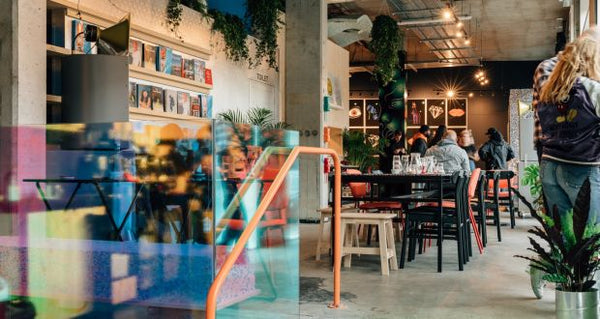 Previously our neighbours just around the corner, Hen’s Teeth have since moved to a bigger and swankier store and studio in Blackpitts, Dublin 8. This very cool shop sells prints, brooks and ceramics, and hosts some great workshops and markets featuring other local makers and artists. Their new set up also has a diner serving some great bites to eat and fab coffee. Great vibes in here.
Previously our neighbours just around the corner, Hen’s Teeth have since moved to a bigger and swankier store and studio in Blackpitts, Dublin 8. This very cool shop sells prints, brooks and ceramics, and hosts some great workshops and markets featuring other local makers and artists. Their new set up also has a diner serving some great bites to eat and fab coffee. Great vibes in here.
 Located in Temple Bar, Scout is a gorgeous lifestyle shop with selections of homeware, knitwear, accessories and top-notch hand picked vintage finds. Those well versed in the Dublin fashion scene will remember the owner Wendy Crawford from from the fab Bow, the shop she ran on a co-op basis in the Powerscourt Centre with Eilis Boyle and Margaret O’Rourke.
Located in Temple Bar, Scout is a gorgeous lifestyle shop with selections of homeware, knitwear, accessories and top-notch hand picked vintage finds. Those well versed in the Dublin fashion scene will remember the owner Wendy Crawford from from the fab Bow, the shop she ran on a co-op basis in the Powerscourt Centre with Eilis Boyle and Margaret O’Rourke.
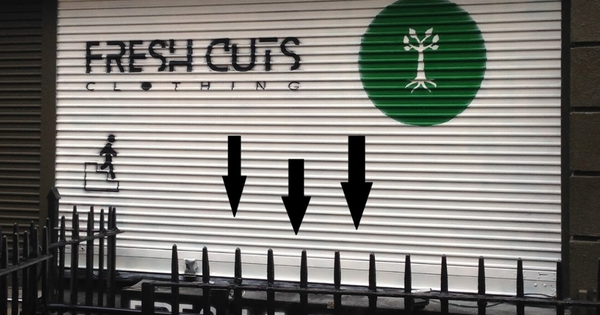 Just up the road from us is Fresh Cuts, a sustainable clothing shop using clean and simple designs. We love that all their labelling, printing and finishing is done right here in Dublin too. Big ups for ethical fashion!
Just up the road from us is Fresh Cuts, a sustainable clothing shop using clean and simple designs. We love that all their labelling, printing and finishing is done right here in Dublin too. Big ups for ethical fashion!

Right on Essex Street in Temple Bar, Indigo and Cloth are a modern and minimalist boutique stocking the best in both Irish and international independent menswear. They also host a Brewbar in tandem with local coffee and tea experts Clement and Pekoe.

We love seeing the bright and cheery vivid pink shopfront of Om Diva each morning. This boutique sells vintage clothing, jewellery and homewares, as well as contemporary pieces by local artists. We love the diversity and creativity here from emerging Irish talent. They also host workshops and stock beautiful pieces by two Dublin makers This Jewellery, one of which we share a studio with!
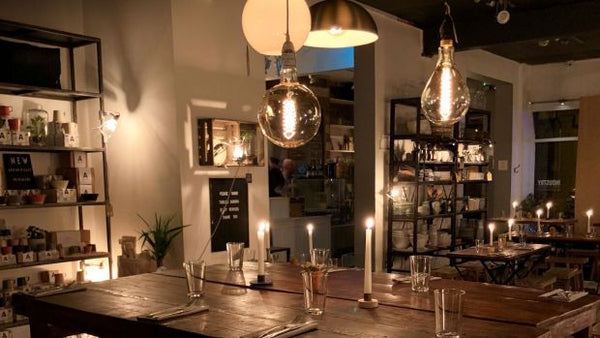 And of course our neighbours, Industry & Co, who specialise in Irish and International design orientated gifts, lighting, and homewares. They also host a fab in store cafe and deli with great coffee.
And of course our neighbours, Industry & Co, who specialise in Irish and International design orientated gifts, lighting, and homewares. They also host a fab in store cafe and deli with great coffee.

Tinnock Farm Candles
Posted by Hannah Gumbrielle in: candle, candlemaking, Christmas gift, dublin
Handmade in small batches in the Sileveardagh Hills in Tipperary, we're big fans of the beautifully scented candles Tinnock Farm creates using 100% soy wax, cotton wicks, and a range of all-natural oils. Each are hand-poured, vegan and have a burn time of roughly 75 hours, as well as being free from paraffin, palm oil and dyes.
Tinnock Farm put an emphasis on sustainability within both their craft as well as their day to day lifestyle. They use no unnecessary packaging, and their small-holding includes an area of hazel coppice, vegetable gardens, a young orchard, streams and paddocks. They aim to be fully self-sufficient, growing much of their own food and reducing waste where possible. Tinnock is also a habitat to a range of native Irish flora and fauna including long-eared bats, red squirrels, pine martins, primroses, bluebells and cowslips to name just a few.
We always have a Tinnock Farm candle burning in our Drury Street, especially their festive Winter Spice to keep us cosy during cold winter days! We asked Kristen Ivors from Tinnock a few questions to learn more about their craft, their process and what inspires them day today. You can check out more of their handmade candles here.

Tell us a bit about what you make.
I make soy wax candles and cold process soap with a focus on quality and simplicity, as well as being zero waste and free from plastic.
Could you describe your studio to us? What is your favourite thing about the space?
I work from an old stable attached to our farmhouse. I love that everything is at my fingertips, I can see across the yard and have lots of room to work! My husband made me a concrete work bench which is the perfect surface for candle making, and all of my work happens on top of that.
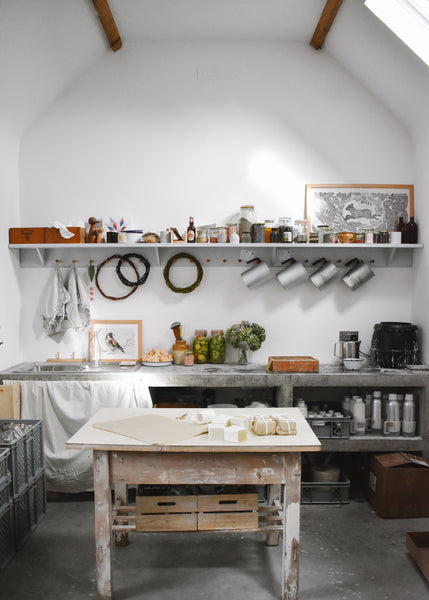
How do you get into the mindset of making?
I love walking into my studio in the morning with a cup of coffee, putting on some music, and starting my work. My dog Woody is my studio companion and he always at my feet while I am mixing or boxing up orders!
What is your favourite tool and why?
My favourite tool is an old jam thermometer that is just great at giving temperatures and stirring wax!

Can you describe your making process to us?
Candle and soap making is all about numbers, temperatures, and a lot of gentle stirring! To start a batch of candles, I melt soy wax flakes in a large boiler and add a touch of coconut wax. After heating the waxes, I mix and stir in my scents, either essential oils, or a combination or essential and fragrance oils, until they are fully incorporated before pouring into jars. When the candles have set, I lid and label them, and they are cured for a few weeks.
What is your inspiration?
Our farm, nature and my gardens as well as the peace that surrounds me everyday. I would love to give everyone a bit of that feeling of calmness when they are lighting their candle!

What led you to choose this craft as a profession? What do you love most about it?
I have always made my own candles and the business grew after some people wanted to buy them. I love how much freedom this craft gives. I spend half of my day making candles and soap, and the other half in the vegetable garden, chopping wood, or checking up on our animals. It gives me the time to be able to run a business but also further our goal of becoming self sufficient.
What is your favourite candle you've created?
My favourite scent changes with the seasons and moods, but you really can’t beat a good lavender candle!
We stock a range of Tinnock Farms handmade candles both in store and online.

Jerpoint Glass
Posted by Hannah Gumbrielle
 Established over forty years ago in Kilkenny, Jerpoint glass has become a household name for producing functional, beautiful tableware using traditional techniques. One of the last remaining glassblowing studios in Ireland, this family owned and operated business remain current with their selection of timeless designs. Working with highly skilled master glassblowers, we asked the co-founder Kathleen some questions about their practice.
Established over forty years ago in Kilkenny, Jerpoint glass has become a household name for producing functional, beautiful tableware using traditional techniques. One of the last remaining glassblowing studios in Ireland, this family owned and operated business remain current with their selection of timeless designs. Working with highly skilled master glassblowers, we asked the co-founder Kathleen some questions about their practice.
Tell us a bit about the history of the company, how it was founded and what is being made today?
Jerpoint Glass Studio is a small glass company and a true family business. Established in 1979 by Keith and Kathleen Leadbetter, together with their small team of glassblowers, they have built Jerpoint Glass into an internationally recognised name.
Keith initially worked in pottery and in laboratory glassblowing in the UK. In the late sixties, he attended the prestigious Orrefors Glass School in Sweden to formally train as a master glassblower. After travelling extensively throughout Europe to develop his skills as a glassmaker, Keith returned to Ireland. Kathleen is a self –taught artist who is passionate about aesthetics and design. She has created the unique coloured glass palette now synonymous with Jerpoint Glass.

Can you describe the studio to us? How many people are on the team?
There are two glassblowers who can work in a team or separately. There are 3 main machines – the furnace, the hole and the lehr. Glass is kept molten in the furnace, reheated in the hole for working with and slowly cooled in the lehr. Much time is spent working/manipulating glass in the work bench.

Can you describe the making process to us?
Working with a material over 1100oC, the glass blower’s day ranges from the balancing act of shaping a paperweight to the intricate dance that forms a wine glass, involving 5 separate gathers of hot molten glass. Yet the simple hand tools of the glassblower have hardly changed since their origins 2000 years ago when glassblowing was introduced.
A master glassblower, using movements that are deceptively minimal develops the desired shape by strategically heating, cooling and manipulating the red-hot liquid glass, until the magical transformation takes place.

What inspires the designs created by Jerpoint?
Certainly our colour palette is very much inspired by the colours in nature. With the beautiful Kilkenny countryside as our backdrop, it’s difficult not to be inspired by the changing landscape; the seasons coming and going and the familiar shades and texture in the surrounding country. Inspiration can be found almost anywhere, we’ll return from a trip with new ideas or just leafing through a book or a magazine.

How do you get into the mindset of making?
We listen to music in the workshop. Rock and Roll!
What is your favourite/most used tool and why?
The Sacs (or Jacks) is a multitool. We use it for everything. It’s adaptable and reliable so it a glassblower’s best friend... Sorry Milo the dog!
How do your surroundings affect your work?
Celebrating 40 years in business this year, we are fortunate to work in the heart of Kilkenny, with Mount Juliet on our doorstep and other woods such as Jenkinstown and Woodstock Gardens nearby. Each year, we witness first-hand, the countryside burst into colour and it is this dramatic transformation that has inspired our offering.

We stock a range of glassware from the master makers at Jerpoint, including small and large tapered jugs alongside matching glass beakers. You can check out the full collection here.

